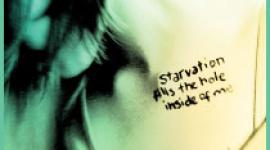Obsessive Compulsive Disorder: When Too Much Isn't Enough

OCD Overview
obsessive-compulsive adj. relating to or characterized by recurring obsessions and compulsions esp. as symptoms of a neurotic state.
Obsessive-Compulsive Disorder is, in short, the repetitive experience of obsessions and/or compulsions that eventually interfere with daily activities, causing the person with OCD to spend hours each day performing compulsive rituals. A common ritual is for the person to wash their hands a certain amount of times at a certain time in a certain order. For someone with an eating disorder, OCD manifests itself by leading the person to count calories methodically, exercise an EXACT amount at a specific time every day, cutting food up in a certain order and in specific shapes, having to have everything perfect (which includes weight), and so on. Because all of these activities are compulsions, meaning that they cannot be controlled until help is sought, it becomes impossible and unbearable for the person afflicted to try and stop on their own.
who.suffers.from.this
About 3.3 million Americans suffer from Obsessive Compulsive Disorder, or about 2.3% of the adult U.S. population in a given year. OCD typically starts during the teenage years or early adulthood, although recent studies have shown that some children develop the illness at earlier ages (at least one-third of cases of OCD in adults began in childhood). Just as with an eating disorder, OCD is not biased - it strikes all ethnic groups with males and females equally affected. Personality-wise, those who have other psychological problems such as depression, an eating disorder, or bipolar disorder tend to be more prone to developing OCD that others. The link that causes these disorders to be more prone seems to be the fact that perfectionism runs high in all of these psychological problems.
why.does.someone.do.this
The person with Obsessive-Compulsive Disorder will usually be able to recognize that their actions are senseless, but at other times the person may be so high strung with fear about not completing a ritual that they believe strongly in their validity. For someone that has an eating disorder, OCD is a way of control over the person's body and therefore, life. The OCD controls what kind of food goes in, what shape the food is, the color, the weight, the amount, what the person does in other areas of life, and so on. By completing the compulsions, the person once again feels "safe" or protected... until they have to perform another task again. Often the two problems - OCD and eating disorders - are linked through the problem of perfectionism. It's been said that the compulsive actions are a response to always feeling that nothing the person does is good enough (whether it has been or not) which has led them to over compensate for things.
I can't hold on
To what I want when I'm stretched so thin
It's all too much to take in
I can't hold on
To anything watching everything spin
With thoughts of failure sinking in-Linkin Park
There has also been a proven biological base to Obsessive Compulsive Disorder, as well. Brain research techniques provided evidence of abnormalities in specific neurotransmitters used by brain cells to communicate with each other. Investigators have used positron emission tomography, or PET, scanners to study the brains of patients with OCD. The PET scans showed different levels of brain activity in certain regions that is not normally present in people that are afflicted with OCD; and it has also been proven that those with OCD have significantly less white matter than people who don't have the problem. Imbalances with the brain chemical serotonin have also been linked to triggering OCD. Serotonin is a neurotransmitter in the brain that helps neurons communicate with each other. However, when serotonin is too low (there is a gap between neurons), it has been proven to cause problems such as over eating, bulimia, and OCD.
receiving.treatment
Although most people with Obsessive-Compulsive Disorder try their hardest to keep their problem from the view of others, inevitably OCD takes over the person's life. It gets to the point where you can't go an hour without performing some kind of compulsive ritual or feeling incredible anxiety. OCD not only attacks a person's sanity, but also their work, school life, family, sleeping, and so on. And just like with an eating disorder, the longer a person goes without getting the help they need and deserve, the aggravated the OCD becomes. Inevitably treatment is needed.
For treatment, a combination of cognitive behavioral therapy and the use of anti-depressant medication have been shown to help greatly with treating OCD and eating disorders. The anti-depressants reduce the severity of OCD symptoms and a concomitant reduction of the anxiety and distress that accompanies the obsessions, while the cognitive behavioral therapy helps with the severity and frequency of OCD.
Common drugs that are used in treating Obsessive Compulsive Disorder and eating disorders are Paxil, Prozac (our nation's favorite), Luvox, Anafranil, and Zoloft. These drugs affect the neurotransmitter serotonin and after about three weeks of use, more than three-quarters of patients are helped by these meds - at least a little. More than half of patients have their symptoms relieved by an anti-depressant, but usually if the medication is discontinued the patient will go into relapse and will feel the same obsessions and compulsions. However, cognitive behavioral therapy has been shown to help patients wean themselves off of their meds safely and without nearly as many relapses.
When anti-depressants and cognitive behavioral therapy are not helping, a specific kind of therapy called "exposure and response prevention therapy" is usually used. This involved the person to deliberately confront the feared object or idea, like a compulsive hand washer having to touch dirt and then not wash his/her hands. A study was done to see just how affective this type of therapy is, and after studying over 300 patients that underwent "exposure and response prevention therapy," an average of 76% still showed clinically significant relief from 3 months to 6 years after treatment. For the majority of patients that complete this therapy, it has been shown to be successful.
references.and.links
HealthyPlace.com extensive Information on Obsessive-Compulsive Disorder
next: Rules' of Support: What and What NOT to Say
~ all peace, love and hope articles
~ eating disorders library
~ all articles on eating disorders
APA Reference
Staff, H.
(2008, December 25). Obsessive Compulsive Disorder: When Too Much Isn't Enough, HealthyPlace. Retrieved
on 2026, January 12 from https://www.healthyplace.com/eating-disorders/articles/obsessive-compulsive-disorder-when-too-much-isnt-enough



